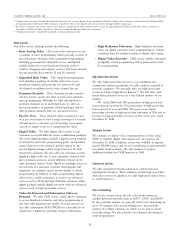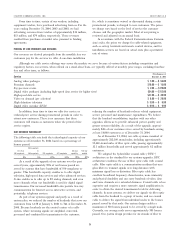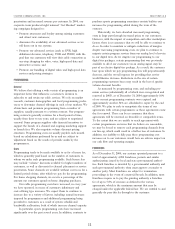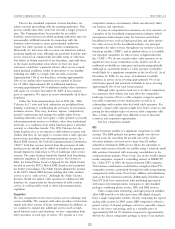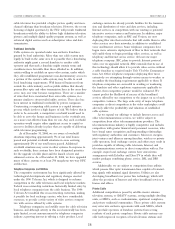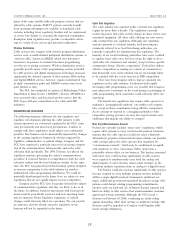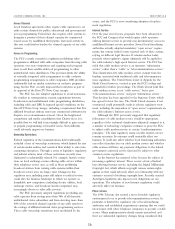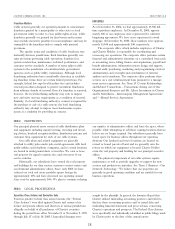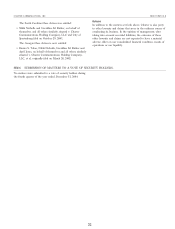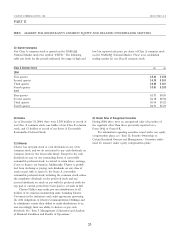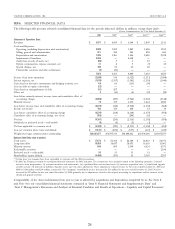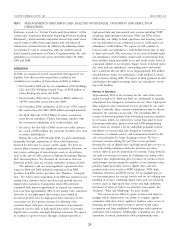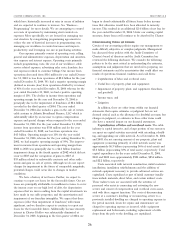Charter 2004 Annual Report Download - page 28
Download and view the complete annual report
Please find page 28 of the 2004 Charter annual report below. You can navigate through the pages in the report by either clicking on the pages listed below, or by using the keyword search tool below to find specific information within the annual report.
CHARTER COMMUNICATIONS, INC. 2004 FORM 10-K
EMPLOYEES
Franchise Matters
Cable systems generally are operated pursuant to nonexclusive As of December 31, 2004, we had approximately 15,500 full-
franchises granted by a municipality or other state or local time equivalent employees. At December 31, 2004, approxi-
government entity in order to cross public rights-of-way. Cable mately 100 of our employees were represented by collective
franchises generally are granted for fixed terms and in many bargaining agreements. We have never experienced a work
cases include monetary penalties for noncompliance and may be stoppage. At December 31, 2003, these numbers were approxi-
terminable if the franchisee fails to comply with material mately 15,500 and approximately 300, respectively.
provisions. The corporate office, which includes employees of Charter
The specific terms and conditions of cable franchises vary and Charter Holdco, is responsible for coordinating and
materially between jurisdictions. Each franchise generally con- overseeing our operations. The corporate office performs certain
tains provisions governing cable operations, franchise fees, financial and administrative functions on a centralized basis such
system construction, maintenance, technical performance, and as accounting, taxes, billing, finance and acquisitions, payroll and
customer service standards. A number of states subject cable benefit administration, information system design and support,
systems to the jurisdiction of centralized state government internal audit, purchasing, marketing and programming contract
agencies, such as public utility commissions. Although local administration and oversight and coordination of external
franchising authorities have considerable discretion in establish- auditors and consultants. The corporate office performs these
ing franchise terms, there are certain federal protections. For services on a cost reimbursement basis pursuant to a manage-
example, federal law caps local franchise fees and includes ment services agreement. See ‘‘Item 13. Certain Relationships
renewal procedures designed to protect incumbent franchisees and Related Transactions — Transactions Arising out of Our
from arbitrary denials of renewal. Even if a franchise is renewed, Organizational Structure and Mr. Allen’s Investment in Charter
however, the local franchising authority may seek to impose and Its Subsidiaries — Intercompany Management Agreements’’
new and more onerous requirements as a condition of renewal. and ‘‘— Mutual Services Agreements.’’
Similarly, if a local franchising authority’s consent is required for
the purchase or sale of a cable system, the local franchising
authority may attempt to impose more burdensome require-
ments as a condition for providing its consent.
ITEM 2. PROPERTIES.
Our principal physical assets consist of cable distribution plant our number of administrative offices and lease the space, where
and equipment, including signal receiving, encoding and decod- possible, while attempting to sell those existing locations that we
ing devices, headend reception facilities, distribution systems and believe are no longer required. Our subsidiaries generally have
customer drop equipment for each of our cable systems. leased space for business offices throughout our operating
Our cable plant and related equipment are generally divisions. Our headend and tower locations are located on
attached to utility poles under pole rental agreements with local owned or leased parcels of land, and we generally own the
public utilities and telephone companies, and in certain locations towers on which our equipment is located. Charter Holdco
are buried in underground ducts or trenches. We own or lease owns the real property and building for our principal executive
real property for signal reception sites and own most of our offices.
service vehicles. The physical components of our cable systems require
Historically, our subsidiaries have owned the real property maintenance as well as periodic upgrades to support the new
and buildings for our data centers, customer contact centers and services and products we introduce. See ‘‘Item 1. Business — Our
our divisional administrative offices. Since early 2003 we have Network Technology.’’ We believe that our properties are
reduced our total real estate portfolio square footage by generally in good operating condition and are suitable for our
approximately 17% and have decreased our operating annual business operations.
lease costs by approximately 30%. We plan to continue reducing
ITEM 3. LEGAL PROCEEDINGS.
Securities Class Actions and Derivative Suits sought by the plaintiffs. In general, the lawsuits alleged that
Fourteen putative federal class action lawsuits (the ‘‘Federal Charter utilized misleading accounting practices and failed to
Class Actions’’) were filed against Charter and certain of its disclose these accounting practices and/or issued false and
former and present officers and directors in various jurisdictions misleading financial statements and press releases concerning
allegedly on behalf of all purchasers of Charter’s securities Charter’s operations and prospects. The Federal Class Actions
during the period from either November 8 or November 9, 1999 were specifically and individually identified in public filings made
through July 17 or July 18, 2002. Unspecified damages were by Charter prior to the date of this annual report.
18


